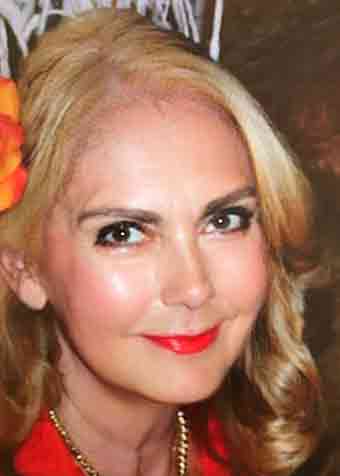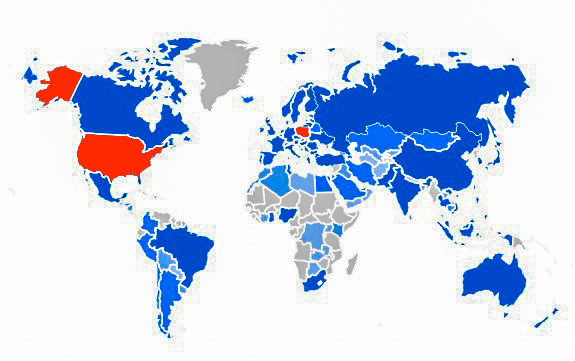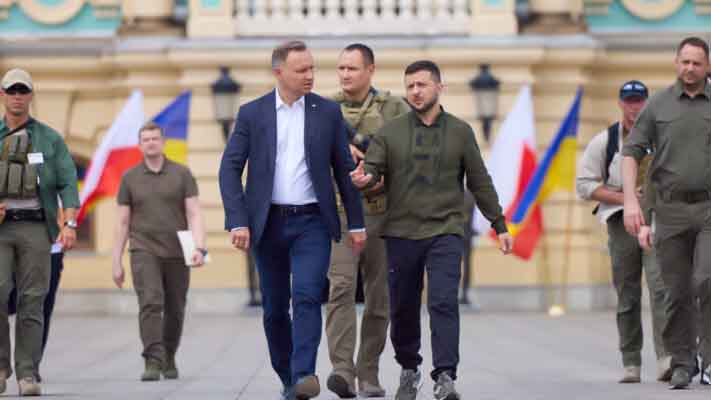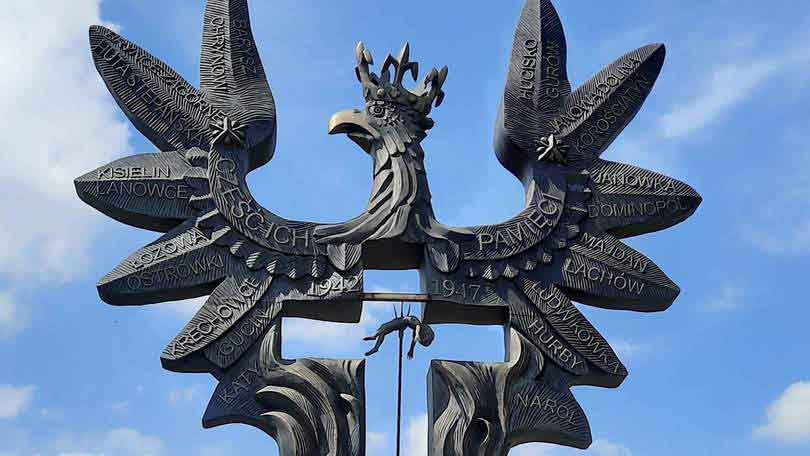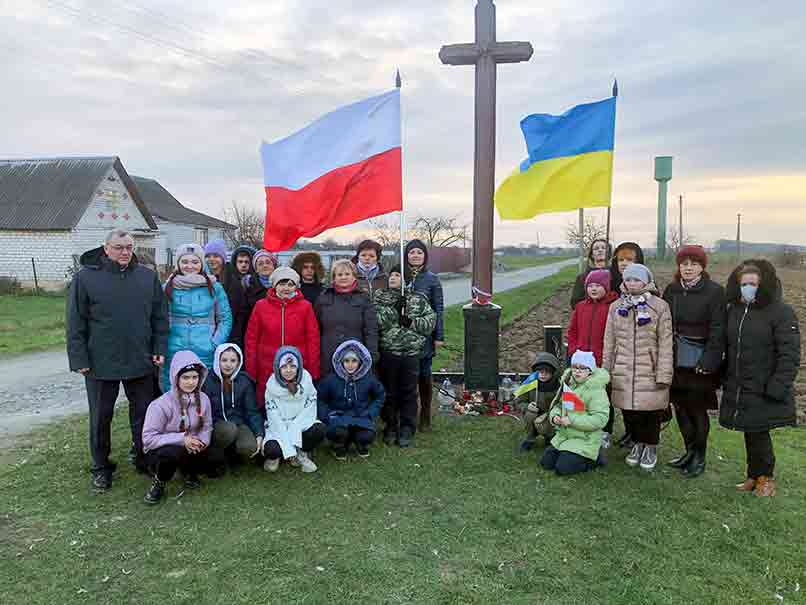This monument was not created out of a desire for revenge, but in memoriam. The monument in honor of the victims of the Volhynian Massacre was ceremonially unveiled on July 14, 2024 in the town of Domostawa, in the Jarocin commune, in the Podkarpackie Voivodeship, on the S19 expressway, on the route between Rzeszów and Lublin.
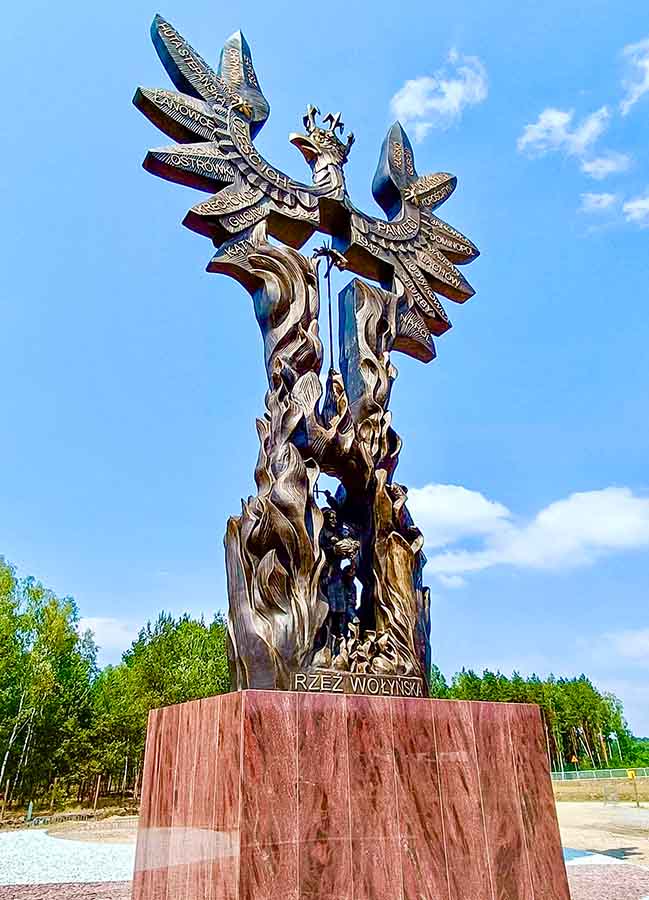
The Volhynian Massacre Monument designed by Andrzej Pityński (Source: Facebook, archives of Kuryer Polski)
Master Andrzej Pityński, the creator of the Volhynian Massacre Monument
A sculptor, a great patriot, extremely sensitive to the suffering of the Polish Nation, he served Poland and the Polish diaspora in the USA with his talent. Through the historical and patriotic themes of his works, he became an honorary ambassador of Polishness in the United States. He created many monumental monuments, most of which are located in the USA. One of the most famous is the "Katyń 1940" monument in Jersey City.
Andrzej Pityński was born in 1947 in Ulanów in the Podkarpacie region. His parents, Aleksander and Stefania, met during the German occupation as AK-NOW (Armia Krajowa — Narodowa Organizacja Wojskowa, Home Army - National Military Organization) partisans. They fought for a free Poland even a few years after the end of the war. Both were members of the "Wołyniak" unit, an implacable enemy of Nazis, communists and Ukrainian UPA bands.
Andrzej Pityński took from his family home a deep sense of patriotism and respect for truth. He reflected this in his later artistic work.
Andrzej graduated from the High School in Ulanów and then the Technical School of Water and Land Reclamation in Trzciana. Some time later he left Ulanów for Krakow, where he began studying at the Teacher Training College. Afterwards he studied sculpture (which turned out to be his true passion and talent) at the Academy of Fine Arts in Krakow with professors Marian Konieczny and Jerzy Bandura.
During this period, Andrzej Pityński’s first significant work was created: the monument to Ignacy Paderewski, which can be admired in front of the Collegium Paderevianum in Kraków.
Motivated by the numerous persecutions of his family and himself by the communist authorities of Poland, Andrzej Pityński decided to leave the country. He managed to do so in October 1974. He flew to the United States. At first, he worked as a construction worker, but at the same time he studied sculpture at the Arts Students League, in the studio of Professor Katz in New York. His career as a sculptor began at the Sculpture House in Manhattan, where he learned the techniques of bronze casting and enlarging monuments. In 1975, he became an assistant to the famous American sculptor Alexander Ettle. It was on his recommendation that he got to the Johnson Atelier – Technical Institute of Sculpture, where after a few years he became the head of the department of artistic modeling.
During his first solo exhibition in New York, he received the Mayor's Award for his sculpture Arthur Rubinstein.
In total, Andrzej Pityński created over 500 works: monuments, sculptures, plaques and medals.
For his artistic and patriotic activities promoting Polish history and culture he received many awards and distinctions. In 2017, the President of the Republic of Poland Andrzej Duda awarded Andrzej Pityński the Order of the White Eagle.

Andrzej Pityński (1947-2020), awarded the Order of the White Eagle (Source: PAP/R. Pietruszka)
There are several monumental sculptures by the master Pityński in Poland. Of note is the monument to the Armed Action of the Polish American Community called the Blue Army, unveiled in Warsaw in 1998. It is a gift from the Association of Veterans of the Polish Army in the USA. In addition, there is the Patriot — a monument erected in 2011 in Stalowa Wola and the monument to the Cursed Soldiers in Jasło.
In his hometown of Ulanów, there is a museum dedicated to the artist's work. Master Andrzej Pityński unfortunately did not live to see the unveiling of the Volhynian Massacre monument in Domostawa. He died on September 18, 2020 in New Jersey, USA. He was 73 years old. His memory lives on in his works.
The origins of the monument commemorating the victims of the Volhynian Massacre
The monument was created at the initiative of the Polish Army Veterans Association (SWAP, Stowarzyszenie Weteranów Armii Polskiej) in America. This patriotic organization was established in 1921 in Cleveland. Andrzej Pityński was a member and activist of SWAP (in the New York district) for 40 years.
The monument to the Volhynian Massacre designed by him was completed in 2017. Unfortunately, neither the artist nor the founders expected the obstacles they would encounter in their homeland. The Polish authorities not only did not support this noble initiative, nor did they contribute even a proverbial penny to its implementation, but they actually made it difficult to erect the already finished monument on Polish soil. Subsequent cities refused to consent to its location: Rzeszów, Stalowa Wola, Jelenia Góra, Toruń, Kielce. The strong Ukrainian lobby played a part in this, expressing opposition to the monument from the very beginning.
Finally, a brave patriot appeared, the then mayor of the Jarocin commune, Mr. Zbigniew Walczak, who proposed locating the monument in Domostawa, a small town between Rzeszów and Lublin. Andrzej Pityński accepted it.
Mayor Zbigniew Walczak also appointed the Social Committee for the Construction of the Volhynia Massacre Monument, which took care of the implementation of the undertaking. In July 2022, a ceremony of consecration and laying the foundation act for the construction of the monument took place. The monument was transported to Domostawa at the expense of the Committee, which collected over PLN 590,000 for this purpose.
Crowds at the ceremonial unveiling of the Monument.
It is difficult to give the exact number of participants in the ceremony. According to estimates, about 15 thousand Poles came to Domostawa, not only from Poland, but also from abroad. A large delegation consisted of representatives of the Polish community from the United States (including the founders of the monument) and Canada.
The festivities on July 14 this year began with the celebration of Holy Mass for the victims. The Holy Mass was celebrated by Fr. Antoni Moskal along with other priests. Unfortunately, the great advocate of truth, the steadfast chaplain of the borderland communities, Fr. Tadeusz Isakowicz-Zaleski, who died in January 2024, was absent.
After the Holy Mass, the Polish National Anthem was sung and then the organizers took the floor. The mayor of the Jarocin commune, Tomasz Podpora, welcomed the numerous Polish patriots who arrived. He spoke about the plans to build a museum of memory of the victims of the Volhynian Massacre next to the monument.
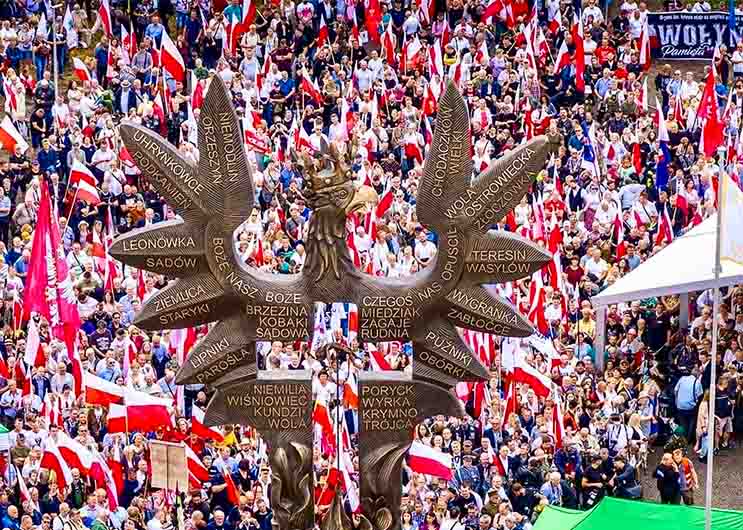
Crowds gathered at the unveiling of the Volhynia Massacre monument in Domostawa, July 2024 (Source: Facebook/Archives of Kuryer Polski)
During the official part, speeches were given by representatives of patriotic circles from Poland, the United States, Canada and Norway. Then, the ceremonial Roll Call of Remembrance began.
Polish veterans from the USA presented Haller Swords to people who made particular contributions to the creation of the monument.
The official part of the ceremony ended with a speech by Dariusz Iwaneczko, head of the IPN (Instytut Pamięci Narodowej, National Institute of Remembrance) branch in Rzeszów, who emphasized how important it is for the Polish nation to commemorate the victims of the Ukrainian genocide.
The last wish of Master Andrzej Pityński was announced by Grażyna Pityńska-Kumik, president of the Andrzej Pityński Patriotic Foundation. He wanted to be ultimately buried on Polish soil, in Ulanów, where he came from, and he made the fulfillment of this wish dependent on the construction of the monument.
It is done. Andrzej Pityński will be buried in his native land. His Polish funeral will take place in October 2024.
The Volhynian Massacre Monument towers over the area
It is a monumental work, 20 meters (66 feet) high (including the base). It has the form of an eagle in a crown, whose spread wings surround a cut-out cross. The names of the towns in which Ukrainians cruelly murdered the Polish population are written on the eagle's wings.
In the upper part of the monument, in the empty space in the shape of a cross, the artist composed a terrifying in its expression figure of a tiny boy impaled on a pitchfork in the shape of a Ukrainian tryzub (trident).
In the lower part of the monument, there are figures of a father, a mother with a baby, a boy and a girl, behind whom on the fence there are children's heads impaled on pickets. Around them are flames. The whole thing is terrifying in its message, just as terrifying the Volhynian crime was.
An unhealed wound
In 2016, the Sejm of the Republic of Poland adopted a resolution on the Ukrainian genocide against Poles and established July 11 as the Day of Remembrance of the Victims of the Volhynia Massacre.
Unfortunately, both the state and church authorities did not remember the victims of this genocide this year. The only gesture that the deputy speaker of the Sejm, Krzysztof Bosak from the Confederation, made was to symbolically lay flowers at the grave-monument of the Unknown Soldier in Warsaw.
It is worth mentioning that in July 2024, Ukrainians from Lviv decided to rebuild the museum of Roman Shukhevych, a criminal in the rank of a Nazi officer of the Nachtigall Battalion, who, as the main commander of the UPA, is responsible for accepting and carrying out the genocidal ethnic cleansing of the Polish civilian population in the Lviv, Ternopil and Stanisławów voivodeships.
It is precisely because these brutal crimes committed against Poles by Ukrainians in the years 1942-1947 are systematically passed over in silence that Witold Gadowski, editor, proposed sending a letter to the President and Prime Minister of the Republic of Poland during the unveiling of the Volhynian Massacre Monument in Domostawa. We are publishing this letter in its entirety.
Demand accepted by 15 thousand Poles gathered in Domostawa
Please reproduce and sign.
We Poles – gathered on July 14, in the Year of Our Lord 2024, at the official unveiling of the Monument to the Volhynian Crimes Committed by Ukrainians – demand that the President and Prime Minister of the Government of the Republic of Poland immediately contact the President of Ukraine with a demand to issue unconditional consent to the mass exhumations of Poles murdered by Ukrainian militias. Our Sisters and Brothers must finally be buried in a Christian manner and placed in marked graves, because this is what Divine and human law requires. Monuments commemorating their martyrdom must be erected at the places of their execution. The President and Prime Minister must also demand an official position of Ukraine, in which an apology will be made to the Polish Nation for the crimes committed by Ukrainian nationalists led by Bandera. We demand compensation from Ukraine for the families of the murdered. At the same time, we demand that the authorities of the Most Serene Republic of Poland prosecute Banderism in Poland and demand its delegalization on the international stage – as a Nazi and criminal ideology. Only the Truth can lead to understanding and cooperation between nations. We demand quick decisions and specific actions for the Polish raison d'état, no geopolitical or economic circumstances can lead to the silence of crimes and marginalization of those who demand redress for the wronged. The war against Russian aggression, which Ukraine is currently waging, cannot stop Polish demands and the truth about the crimes demands international publicity. Enough of trading in the blood of murdered Poles, enough of the cowardice of successive Polish governments and politicians. In the spirit of Christian mercy, we demand confession of sins, repentance and redress.
This appeal was adopted by acclamation on 14 July 2014 by a crowd of several thousand Poles gathered in Domostawa during the ceremony of unveiling the monument to the Volhynian Massacre.
Translation from Polish by Andrew Wozniewicz.



